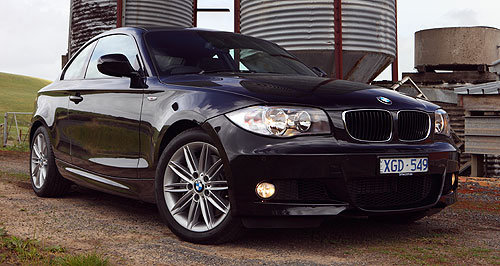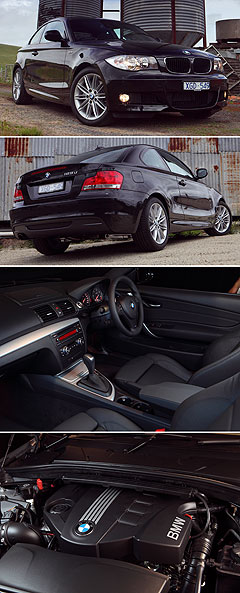First drive: BMW 123d puts fun into frugality
BY BYRON MATHIOUDAKIS | 9th Dec 2009

On sale now, it is one of 10 new BMW variants brandishing the EfficientDynamics sub-brand.
Fitted to the $50,790 E87 1 Series 123d five-door hatch as well as the $57,900 E82 1 Series 123d two-door coupe, the twin-turbocharged 2.0-litre four-cylinder diesel powerplant employs BMW’s Variable Twin Turbo technology using a small and large exhaust gas turbochargers.
With its low inertia characteristics, the smaller turbo takes care of low engine speed loads to help cut lag while the larger one provides the extra induction-forced oomph, effectively giving the 123d vehicles virtually instant torque accessibility across a wide rev range.
The 123d powerplant is also the first BMW engine with common-rail direct injection technology with Piezo injectors that deliver fuel into the combustion chamber at a pressure of 2000 bar.
It effectively takes the place of two older 1 Series variants – the E87 120d manual with the 125kW/340Nm engine (the 120d auto version continues) and E87 130i with the 195kW/315Nm 3.0-litre in-line petrol six-cylinder unit.
This is also the first time the E82 coupe gains a diesel engine in Australia.

But the twin-turbo BMW strikes back with a 15kW power and 50Nm torque increase from what is essentially the same 1995cc 2.0-litre diesel unit found in the 118d and 120d models.
In both 123d guises, the vital stats are 150kW at 4400rpm, 400Nm from 2000 to 2250rpm, 0-100km/h in 7.0 seconds (auto: 7.1s), 5.2 litres per 100km in the combined fuel consumption cycle (auto: 5.6L/100km), and 138 grams per kilometre of carbon dioxide emissions (auto: 148g/km).
The latter figures are aided by the inclusion of EfficientDynamics measures such as an idle-stop function that cuts the engine at idle in neutral with the clutch depressed, an optimum shift indicator in the instrumentation panel (telling the driver when to change up or down a gear via an LED display), electric power steering (replacing the hydraulically powered item found on most other BMWs) and brake energy regeneration (generating electric power from energy otherwise wasted as lost heat via the brake system).
By contrast, BMW says, the corresponding $47,900 Audi A3 2.0 TDI trails the 123d by 25kW, 50Nm, 0.6s, 0.1L/100km and 1g/km – but the Ingolstadt car is $5690 less if we are comparing hatches and $12,964 less than the 123d Coupe.
No 123d Convertible is offered.
As with all 1 Series models from the current 118i upwards, the rear wheels are driven via a choice of a six-speed manual gearbox or a six-speed automatic transmission BMW calls Steptronic.
The 123d joins the widest ever 1 Series range to be sold in Australia, and brings the total of sub 6.8L/100km BMWs on sale to 23.
It also tops off a busy year for the company which has changed 60 per cent of its model range in the past 12 months in Australia.
Australia is also the only place outside of Europe to have the EfficientDynamics philosophy applied to the BMW range, ahead of the North American and Asian markets.
| 2010 BMW 123d range pricing: | |
| 123d Sports Hatch: | $50,790 |
| 123d Sports Hatch (a): | $53,070 |
| 123d Coupe: | $57,900 |
| 123d Coupe (a): | $60,864 |
| 123d Convertible: | $67,200 |
| 123d Convertible (a): | $65,664 |